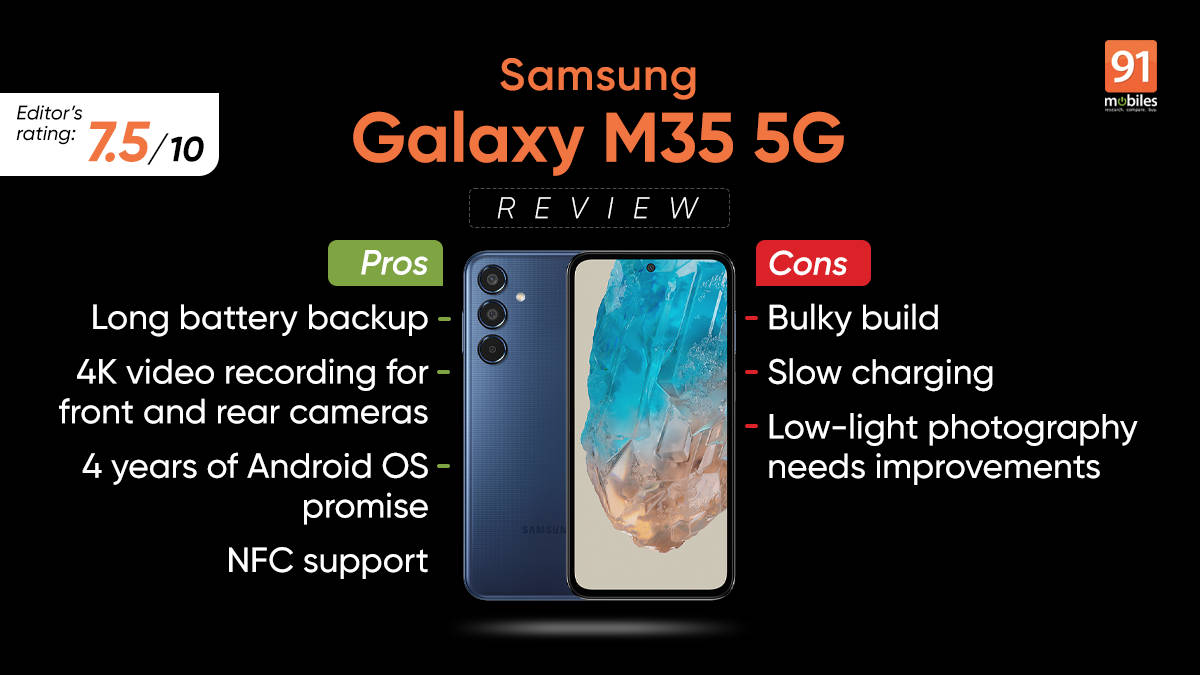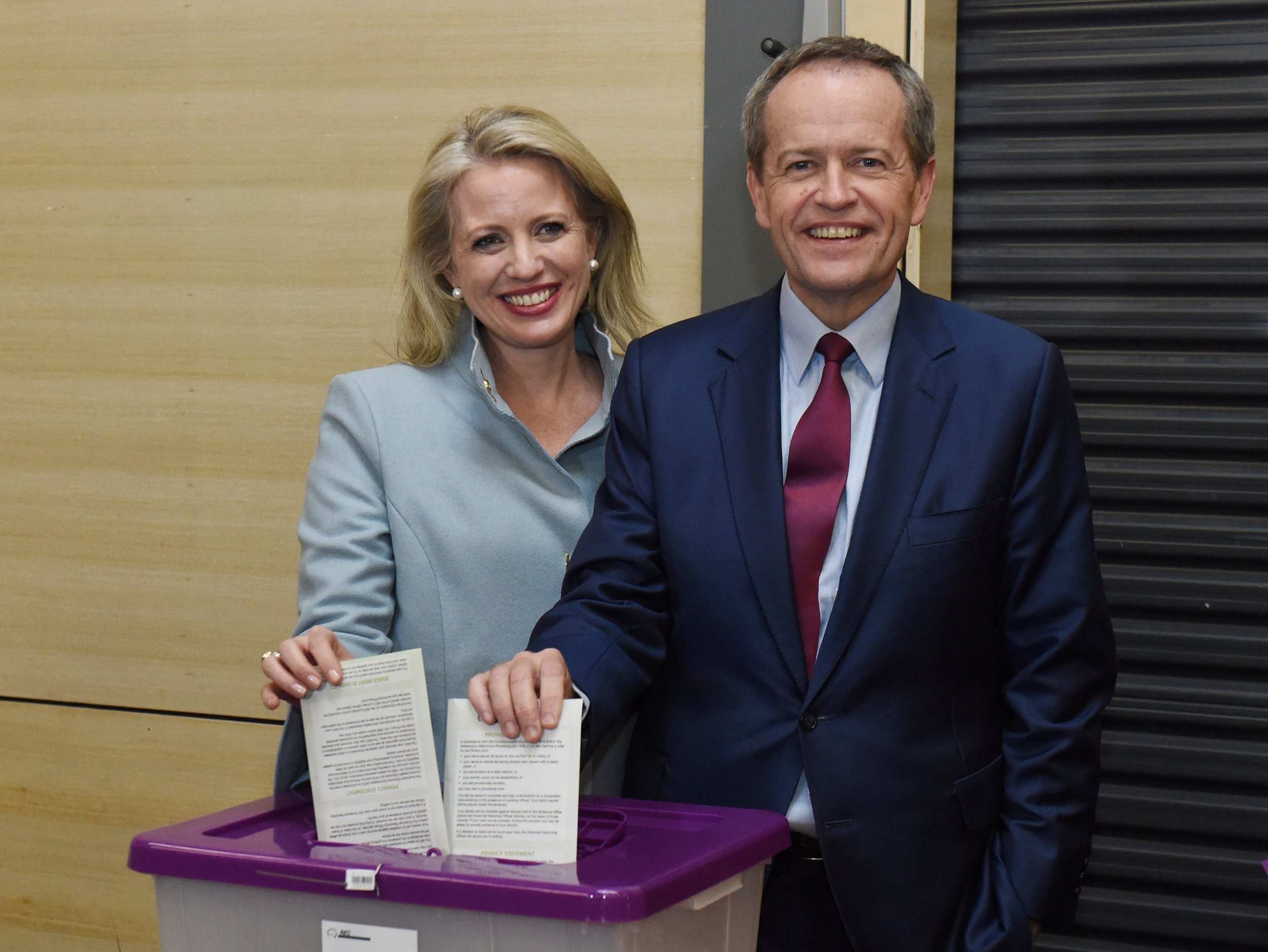Samsung’s latest Galaxy M35 5G is sure to catch your attention if long battery life is a priority. With its 6,000mAh battery, it promises nearly 31 hours of uninterrupted video playback and up to 53 hours of talk time. The phone also offers enhanced screen durability compared to last year’s Galaxy M34 5G (review). Other thoughtful features include NFC support, a new processor, and improved connectivity options – all for a slight increase in price over last year’s model.
At the same time, some old Samsung issues remain constant, particularly with regards to charging. Read on to know more.
Verdict
For daily work, the Samsung Galaxy M35 5G is a good choice, especially if battery life matters to you. Samsung has also been thoughtful about adding NFC support, which should help users relying significantly on digital transactions. The new Exynos chipset provides improved performance over last year’s model. However, Samsung still needs to improve the low-light camera performance, perhaps in the next iteration. Reducing the weight without compromising battery capacity would also be a significant step forward.
Design and display

The Galaxy M35 5G, like last year’s Galaxy M34 5G, maintains a minimalist design. The triple cameras on the back are still arranged in an evenly spaced vertical layout, with the company logo neatly positioned near the bottom half. The font remains the same as previous models, but the colour is updated to match the phone’s overall aesthetics. This approach isn’t exclusive to Samsung, but I’ve noticed that most brands are opting for silver logos. While it creates a sleek, modern look, it can become monotonous for someone like me who tests smartphones for a living.
| Samsung Galaxy M35 5G |
OnePlus Nord CE4 Lite | iQOO Z9 | |
| Thickness | 9.1mm | 8.1mm | 7.8mm |
| Weight | 222 grams | 191 grams | 188 grams |
| IP rating | NA | IP54 | IP54 |
Samsung offers three colours for the Galaxy M35 5G, which is good to see as most competitors struggle to go beyond two variations. I reviewed the Light Blue model, which seems to be a suitable option for young customers looking for bright colours. The Moonlight Blue variant appears to be a safe option for someone who does not like to experiment with bold looks. The Gray variant sits between the two, making it a good choice for older customers who prefer a more understated, less flashy look for their phones.
Otherwise, the Galaxy M35 5G is heavy and chunky, which isn’t surprising given the massive 6,000mAh battery. Compared to its predecessor, the weight has been slightly increased, although it is not ideal. Using the device should not necessarily feel cumbersome though, thanks to the smooth back panel and rounded edges. The weight distribution has been carefully considered and implemented.
The sides have the standard ports and buttons selection, including a USB-C port for charging, volume rocker, and a power button doubling as a fingerprint scanner. Sadly, Samsung has decided to ditch the 3.5mm jack this year, likely to cap the thickness and weight. We also get a hybrid SIM tray, meaning there’s support for expandable storage of up to 1TB via a microSD card.


While the overall design is reminiscent of last year’s Galaxy M34, the front panel gets major upgrades. The Galaxy M35 5G incorporates a relatively taller 6.5-inch full HD+ (2,340 x 1,080 pixels) AMOLED display with 120Hz refresh rate. Samsung has also removed the antiquated water drop-style notch and added a hole-punch cutout for an uninterrupted viewing experience. The bezels across the display remain thick, but Samsung compensates it by offering Corning Gorilla Glass Victus+ protection, which surely will live up to its “monster durability” tag.
To elevate the punchy viewing experience, Samsung has also added a dual speaker setup with Dolby Atmos support. I am satisfied with the overall volume, but the bass thump could be improved. Viewing angles and brightness are also decent, if not the best.
| Samsung Galaxy M35 5G |
OnePlus Nord CE4 Lite | iQOO Z9 | |
| Display | 6.6-inch | 6.67-inch | 6.7-inch |
| Peak brightness | 1000nits | 2100nits | 1800nits |
The OnePlus Nord CE4 Lite (review) still offers the brightest viewing experience under harsh sunlight in this segment, which I also found during its comparison against the Realme P1 (review). Indoors, the Galaxy M35 5G offered a similar viewing experience compared to Nord CE4 Lite and iQOO Z9 (review), though the Samsung phone might lag slightly due to its thicker bezels. However, its colour reproduction remained the most natural and accurate.
Cameras
The Galaxy remains among the fewest smartphones in the segment to include three cameras on the back. That being said, the camera setup remains the same as last year. The triple camera setup is headlined by a 50MP primary camera with auto-focus but without OIS (optical image stabilisation) support. There’s also an 8MP ultra-wide and a dedicated 2MP camera for macro shots. The front continues to include a 13MP, now in a hole-punch cutout.


In summary, photos captured by Samsung Galaxy M35 5G feature vibrant colours, though details can be sketchy. The phone also tends to play with contrast and shadows for a dramatic approach, making its images more social media-ready. In low-light conditions, details aren’t always the best, and you may notice noise in the final output.
Images with human subjects can appear aesthetically pleasing, but it all depends on the ambient light. However, selfies, especially in dim conditions, need improvement. I’ve also compared its photos with iQOO Z9 and the OnePlus Nord CE4 Lite, though their biggest camera setback is the lack of an ultra-wide lens. You can see the comparisons below.
Daylight and low-light
If you see these shots by the Galaxy M35 5G and OnePlus Nord CE 4 Lite, you will notice a visible difference in the colour science. As mentioned, the Galaxy M35 5G offers vibrant colours, though the Nord CE4 Lite captures more readable signs in the background (images below). Samsung has also done a decent job with the dynamic range, though it can get inconsistent.
Even colour science may not be consistent when switching to 2x mode. In the photo below, iQOO Z9’s output looks more natural, whereas the colours in Samsung’s image are slightly muted.
In dim conditions, Samsung can capture aesthetically pleasing shots, but again, its details aren’t always the best.
Both low-light shots, taken with night mode enabled, show noticeable differences in brightness and sharpness.
Portrait and selfies
As mentioned, the Galaxy M35 5G can capture good images with human subjects, but it all depends on the lighting conditions. I like this shot with the Samsung phone much better, even though the iQOO Z9’s output offers more brightness. The former was able to capture a near-accurate skin tone of the subject.
Its selfies look decent, if not better than the iQOO Z9.
However, in low light, the Galaxy M35 5G struggles with stabilisation and even colours to an extent.
There’s a significant difference between the two images above, with one being captured with the Nord CE4 Lite, despite enabling night mode on both smartphones.
Videos
If you’re considering content creation, the Galaxy M35 5G could be a solid option – provided you can manage extra lighting for your space. The phone struggles to minimise contrast, and the output may appear darker than usual in dim conditions. In low light, videos might feature muted colours, and the stabilisation isn’t always the best.
On the plus side, Samsung has thoughtfully included 4K recording support for both front and rear cameras, a feature that most rivals in this segment are yet to offers.
Performance and software
This year, Samsung has tweaked storage configurations. The base model continues to offer 6GB RAM and 128GB storage but for a slightly increased price of Rs 19,999. The 8GB RAM option with the same storage, which I am reviewing, costs Rs 21,999. The new storage variant with 8GB RAM and 256GB storage costs Rs 24,999.


Another change includes the addition of Samsung’s Exynos 1380 SoC for an improved performance.
| Samsung Galaxy M35 5G | Samsung Galaxy M34 5G | |
| AnTuTu | 611292 | 488166 |
| Geekbench (single and multi-core scores) | 1008, 2926 | 953, 2000 |
Based on our benchmarks, the Galaxy M35 5G performed better than its predecessor in AnTuTu and Geekbench. Even compared to the OnePlus Nord CE4, its scores were better. However, the iQOO Z9 powered by MediaTek Dimensity 9200 SoC continues to dominate the sub-Rs 20K segment. If we move to the sub-Rs 25K segment, the Galaxy M35 5G does slightly better than rivals like Motorola Edge 50 Fusion and Realme P1 Pro, although it’s behind performance-focused devices like Infinix GT 20 Pro (review) and OnePlus Nord CE 4 (review).


In real-life use, the Galaxy M35 5G performed decently. You might notice some lag when switching between apps, but this is common among smartphones in this segment. The phone comes with Android 14-based One UI 6.1 and is promised four years of major Android OS updates, which is a fantastic offering. Additionally, with an extra year of security updates, you can comfortably use the device for up to five years.


For the gaming test, I compared the Galaxy M35 5G against iQOO Z9 and OnePlus Nord CE4 Lite. We checked the performance after 60 minutes of BGMI and COD playtime. The average battery drop at the end of the round stood at 6 percent across the three smartphones, though in absolute numbers, the Galaxy M35 5G consumed more battery (360mAh).


Interestingly, it managed thermals more efficiently despite performing poorly in our CPU throttle test.
| Pre-installed apps | OS Updates | |
| Samsung Galaxy M35 5G | 52 | 4 years OS + 5 years security updates |
| OnePlus Nord CE4 Lite | 50 | 2 years OS + 3 years security updates |
| iQOO Z9 | 55 | 2 years OS + 3 years security updates |
The software experience was generally decent, though Samsung might want to consider turning off “Glance” by default. When enabled, users are subjected to ads on the lock screen, which can affect the usage experience. On the positive side, you can enjoy a smooth Android ecosystem with native Samsung apps. The Galaxy M35 5G also includes NFC support, which is particularly useful given India’s growing emphasis on digital payments.
Battery and charging
The Galaxy’s M35 5G key highlight, like last year’s Galaxy M34, is the battery. While it showcased decent performance in PCMark’s battery test, lasting for nearly 14 hours.


This was an hour longer than Galaxy M34’s backup in the same test last year. This may not be the best performance, likely due to app optimisation, but its 6,000mAh battery can prove to be highly useful in real-life usage.


In our tests, the phone easily lasted a full day with high settings enabled. However, the downside of the large battery is the slower charging speed, as Samsung has yet to match the rapid charging offered by its competitors.
| Smartphone | Charging Time (20-100 percent) |
| Samsung Galaxy M35 5G (25W) | 96 minutes |
| OnePlus Nord CE4 Lite (80W) | 50 minutes |
| iQOO Z9 (44W) | 62 minutes |
Additionally, Samsung continues to exclude a charger from the box, providing only a Type-C to Type-C cable. This means your old adapter with a Type-A port won’t be sufficient.
Final verdict
For productivity-focused users, the Samsung Galaxy M35 5G can prove to be a reliable companion, especially if a long battery matters to them. I am also happy to see Samsung not making compromises in areas like software update cycle, NFC, and 5G, which might appeal to many customers.
Gaming-focused users can consider the iQOO Z9, which offers a smoother performance. If BGMI is your go-to title, the Infinix GT20 Pro offers the best app optimisation. Even for cameras the Samsung Galaxy M35 5G is decent, but the iQOO Z9 offers versatility in low light.
If you’re okay with standard camera performance but prioritise good battery life and a long-term Android update promise, the Galaxy M35 5G is a solid option to consider.
Editor’s rating: 7.5 / 10
Reasons to buy
- The Galaxy M35 5G offers a long battery backup.
- There’s 4K video recording support for front and rear cameras.
- It promises 4 years of Android OS updates.
- There’s NFC support on the Galaxy M35 5G.
Reasons to not buy
- The Galaxy M35 5G has a bulky design.
- The charging speeds are relatively slow.
- The Galaxy M35 5G’s low-light photography needs improvements.






